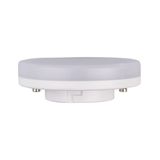- Home /
- SPL Lighting +
- LED lamps and tubes /
- SPL Lighting LED lamps and tubes +
- LED Spotlight bulbs /
- SPL Lighting LED Spotlight bulbs +
- GX53 LED Tablet bulbs /
- SPL Lighting GX53 LED Tablet bulbs
SPL Lighting GX53 LED Tablet bulbs

spl lighting g53 ar111 led bulbs range and form factors
AR111 bodies keep the classic Ø111 mm footprint with G53 two-pin base, so trims, snoots, and gimbals from legacy fittings stay in play. Typical wattage nodes sit at 10/12/15/18 W with outputs around 900–1 600 lm depending on beam and CCT. Beam sets cover 8° punch for vitrines, 15°/24° for merchandise “hot spots,” and 36°/45° for broader pools. CCT packs 2700/3000/3500/4000 K; CRI 80 runs daily duty, while CRI 90 with healthy R9 is stocked for food, wood, textiles, and skin tones. IP20 at the lamp is standard; face IP rises with the host luminaire and accessory ring.
spl lighting ar111 reflector lamps optics and beams
Two optical architectures dominate. TIR lens engines deliver tight cut-off, high CBCP, and clean edge gradients; they’re the go-to when you size by centre-beam at the working distance (not lumens). Glass/metalized reflectors read more “halogen” in heritage trims and are forgiving in direct view. Expect CBCP from ~2 000 cd (15 W, 24°) to well past 4 000 cd (15 W, 8°); publish the throw distance and target lux so the shop floor lands right the first time. Accessories—honeycomb, soften, and spread films—control near-field sparkle on glossy stone, lacquer, and foils without losing beam shape.
spl lighting high power led spots drivers and control
Most AR111 LEDs are 12 V nominal and accept AC/DC. In small groups, LED-rated electronic transformers with low minimum load work; for longer multi-head runs, a constant-voltage 12 V driver per circuit is steadier. If your spec needs scene control, pair external drivers on 1–10 V or DALI-2 DT6; lamp-integrated dimming on phase-cut prefers trailing-edge (RC) for quiet low-end. Pro bins target PF ≥ 0.90 (≥12–15 W), THD ≤ 15 %, and flicker metrics around PstLM ≤ 1.0 / SVM ≤ 0.4 for camera-heavy retail. Keep secondary leads short; long twin-lead runs shave dimming headroom and tilt CCT on low levels.
spl lighting commercial spot lamps applications and layouts
Retail aisles and tables: 24° at 3000/3500 K, CRI 90, aimed to cross-light and lift texture without washing verticals. Galleries and vitrines: 8°–15°, CRI 90 at 3000 K with honeycomb; set CBCP to reach 1500–2500 lx at distance without glare for viewers. Hospitality bars and lobbies: 36°/45° pools at 2700/3000 K; keep luminance under control with baffles in low ceilings. In mixed estates, harmonise CCT/CRI with panels and linears so colour doesn’t jump between layers.
Construction, thermal path, and life
Die-cast or heat-loaded polymer crowns move heat straight off the board; Tc pads are marked and must remain ≤ 85 °C. Fronts are PMMA/TIR or tempered glass with UV-stable seals. Typical lifetime claims: L70/L80 25–50k h at Ta 25 °C (LM-80/TM-21 sourced). Operating window −20…+40 °C; insulation against the crown shortens life and nudges colour on CRI-90 engines. Surge ride-through is usually 1–2 kV L-L; where lifts/VFDs share the board, add an upstream SPD.
Standards and interfaces you’ll actually use
- LED source/module: EN/IEC 62031; driver performance: IEC 62384; integrated gear: EN/IEC 61347-2-13.
- Retrofit safety/marking where applicable: EN/IEC 62560.
- EMC: EN 55015 / EN 61547; mains quality: EN 61000-3-2 / -3-3
- Photobiological safety: EN 62471 (RG0/RG1 at typical outputs).
Holders follow IEC 60061 G53 geometry; use T-rated lampholders in insulated or shallow cans.
Series map and assortment logic
- TIR Accent — 8°/15°/24°, highest CBCP, matte crowns to hide glare; CRI 90 focus for fashion, leather, timber.
- Reflector Classic — 24°/36°/45°, halogen-like look, forgiving in direct view; strong pick for heritage trims.
- Warm-Dim — 3000 → ~1800 K curve for dining and lounge zones; lower peak lm by design but very convincing ambience.
- Short-Neck — reduced overall length for tight gimbals and shallow plaster rings.
Across the families, bins are held to ≤ 3 SDCM so replenishment lots don’t drift on colour.
Planning notes that cut commissioning time
- Size by CBCP at working distance, then pick wattage. A 15 W 8° can outperform a higher-lumen 36° on the target plane.
- Declare dimmer topology per area. Mixing RL/RC on one floor causes chatter at low end.
- Keep secondary runs short on 12 V; voltage sag is the usual reason spots won’t dim smoothly.
- Match CCT/CRI to adjacent layers; a 3500 K accent over 3000 K ambient reads cold.
- For bathrooms/wash-adjacent zones, use sealed front rings in the host downlight; the lamp remains IP20.
Procurement and B2B kit notes
Quote each node with: beam (°) + lumen/CBCP at target distance + CCT/CRI + cap/base (G53) + dimming note (RC/1–10 V/DALI-2) + overall length + surge class. Add accessory codes (honeycomb/soften/spread) on the same line; they’re the first items scuffed late in a program. For transformer estates labelled as spl lighting g53 spotlight bulbs, include minimum-load data and the approved transformer list to avoid low-end flicker.